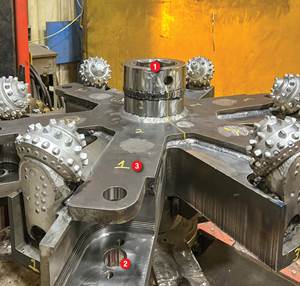Key Elements of the World’s Largest Inverted VTL
A number of noteworthy design elements enable this inverted vertical turret lathe to accurately and effectively machine very large components.
Share





Inverted vertical turret lathes (VTLs) are distinctive in that they serve as their own parts loader, using their downward-facing main spindle to pick up staged workpieces and deliver them to the machining zone. This yields a more compact footprint than other automated machining systems because no auxiliary loading equipment is needed. And because the spindle carrying the workpiece is positioned vertically above the tools, hot chips fall unhindered into a conveyor, preventing them from contaminating the machine’s main spindle or collecting upon and heating up the workpiece.
Emag’s multifunction VLC 1200 is said to be the world’s largest inverted VTL. It can pick up and machine 1,500-kg workpieces with diameters as big as 1.2 meters. Such large-part machining capability makes the VLC 1200 well-suited for manufacturing precision components used in construction machinery, industrial transmission systems and wind-turbine generating systems. Plus, the machine can perform multiple operations in a single setup, including turning, drilling, milling, grinding and gear cutting. This flexibility improves throughput while minimizing work-in-process as well as transport of big, bulky components throughout a manufacturer’s facility.
A number of noteworthy design elements enable the VLC 1200 to accurately and effectively machine very large components. Here are a few:
• Polymer-granite machine base—The VLC 1200 features a portal design with a U-shaped base made of a polymer-granite material called Mineralit. This engineered granite offers many benefits over traditional welded steel or cast iron beds. For instance, the material’s inherent stability mitigates thermal distortion traditionally observed in a steel or cast iron base. This is also why the polymer-granite material is 30 percent more effective in damping vibration compared to traditional base materials, according to the company. Less system vibration leads to better surface finishes and longer tool life while enabling aggressive cutting parameters.
• Fluid-cooling system—Although the VLC 1200’s bed is made of polymer granite, other critical assemblies have steel or cast iron frames. One example is the cast iron main spindle carrier that spans the top of the U-shaped base to create a box-frame structure with minimal component overhang. A closed-loop coolant system ensures that the spindle carrier as well as the turret, feed axes and other such components maintain a consistent temperature to ensure thermal stability.
• Powerful milling spindle with beltless drive—The machine’s milling spindle is located below the main spindle. It offers as much as 52 kW of horsepower and has an HSK A100 interface for heavy cutting applications. According to the company, a beltless-drive design eliminates backlash, feedback error and vibration to deliver quality surface finishes and precise geometries.
• On-machine part probing—A touch probe inside the machining area serves as an in-process gage to measure a workpiece still clamped in the machine to an accuracy of ±2 microns. Nominal corrections based on probe feedback are made automatically to the part program as necessary. The probe can also be used for measuring a semi-completed part feature after a tool change (before the machining operation reaches full depth). This is especially useful when machining large parts that require multiple identical tools to create a given feature.
Because the probe is mounted directly on the machine’s polymer-granite bed, its position with respect to the machine will not change due to thermal fluctuations (unlike probes installed on moving arms). A fixed probe location also offers a known home position, which simplifies machine calibration routines.
Related Content
Inside a CNC-Machined Gothic Monastery in Wyoming
An inside look into the Carmelite Monks of Wyoming, who are combining centuries-old Gothic architectural principles with modern CNC machining to build a monastery in the mountains of Wyoming.
Read MoreHow a Custom ERP System Drives Automation in Large-Format Machining
Part of Major Tool’s 52,000 square-foot building expansion includes the installation of this new Waldrich Coburg Taurus 30 vertical machining center.
Read MoreSelect Machining Technologies Highlights Multitasking Machines
IMTS 2024: Select Manufacturing Technologies is highlighting large-capacity multitasking machines from Solace, Geminis, Ibarmia and Momentum.
Read MoreThe Cut Scene: The Finer Details of Large-Format Machining
Small details and features can have an outsized impact on large parts, such as Barbco’s collapsible utility drill head.
Read MoreRead Next
AMRs Are Moving Into Manufacturing: Considerations for Implementation
AMRs can provide a flexible, easy-to-use automation platform so long as manufacturers choose a suitable task and prepare their facilities.
Read MoreMachine Shop MBA
Making Chips and 91ÊÓƵÍøÕ¾ÎÛ are teaming up for a new podcast series called Machine Shop MBA—designed to help manufacturers measure their success against the industry’s best. Through the lens of the Top Shops benchmarking program, the series explores the KPIs that set high-performing shops apart, from machine utilization and first-pass yield to employee engagement and revenue per employee.
Read MoreLast Chance! 2025 Top Shops Benchmarking Survey Still Open Through April 30
Don’t miss out! 91ÊÓƵÍøÕ¾ÎÛ's Top Shops Benchmarking Survey is still open — but not for long. This is your last chance to a receive free, customized benchmarking report that includes actionable feedback across several shopfloor and business metrics.
Read More






















